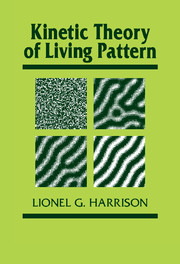Book contents
- Frontmatter
- Contents
- Preface
- Part I Macroscopics without mathematics
- Part II Pattern-forming processes
- 5 The making and breaking of symmetry
- 6 Matters needing mathematics: an introduction
- 7 Kinetic models for stable pattern: an introduction
- Part III Bringing experiment and theory together
- References
- Index
7 - Kinetic models for stable pattern: an introduction
Published online by Cambridge University Press: 22 September 2009
- Frontmatter
- Contents
- Preface
- Part I Macroscopics without mathematics
- Part II Pattern-forming processes
- 5 The making and breaking of symmetry
- 6 Matters needing mathematics: an introduction
- 7 Kinetic models for stable pattern: an introduction
- Part III Bringing experiment and theory together
- References
- Index
Summary
The optical-resolution mechanism of the preceding two chapters is the basic self-organizing asymmetrizer. But its enthusiasm outruns its discretion. Its final outcome is to leave the system, macroscopically, as symmetric at the end as it was at the start, by the rejection, on the molecular scale, of all molecules of one symmetry. (Even for this simplest model, the interplay of molecular and large-scale symmetries and asymmetries is rather subtle.) The game is played to this extremity because, as explained in Section 6.4, the exponential growth rate constant kg of pattern amplitude increases monotonically with wavelength. Thus the longest wavelength, spatially infinite uniformity, is ultimately favoured.
The basic difference needed to produce stable nonuniform pattern was described qualitatively in Section 3.1.2 with reference to Figure 3.2. Above some finite wavelength designated λm the growth rate kg must fall. We must now consider what has to be added to the simplest reaction-diffusion model to give it this characteristic. In general, at least one more morphogen is needed. The interplay of two morphogens cannot be analyzed fully without mathematics. An illustration devised by Maynard Smith (1968) is described in Section 7.1. It shows the need for the form of the cross-interactions between morphogens X and Y and for the relative values of their diffusivities. Such a simple illustration cannot, however, reveal all the important properties of such complex and subtle dynamics. It shows that X and Y may settle down into standing waves in phase with each other.
- Type
- Chapter
- Information
- Kinetic Theory of Living Pattern , pp. 223 - 246Publisher: Cambridge University PressPrint publication year: 1993



